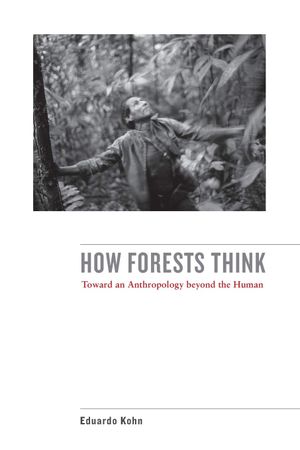
How Forests Think: Toward an Anthropology Beyond the Human
by Eduardo Kohn
read in Nov 2020
book info on goodreads
Kohn’s main objective with the book is to develop a new kind of anthropology that goes beyond the human. That means he tries to overcome the social-material dualism that has been introduced as part of what he calls the double-edged sword that is social constructivism… He argues that other attempts at this endeavour have so far failed at it by attempting to erase the divide through ontological symmetry and that the issue of ontological inseparability will always appear elsewhere.
Kohn takes a different approach to moving beyond the social-material dualism grounded in semiotics. He argues that we need to radically rethink what representation is, even in the social domain. He thereby critiques two major problems with existing approaches to theorising humans and non-humans. He argues against a theorising of sociomaterial relationships in terms of materiality (i.e., attributing agency or even intentionality to materials) and also in terms of assumptions about linguistic relationships (i.e., projecting human representation to material objects).
With this approach he tries to critique existing perspectives from STS, probably the most influential field in trying to take matter seriously, and in particular Bruno Latour’s work. He critiques these attempts by arguing that not all non-human things should be treated as equal, he suggests that there is an important difference between non-human living things and dead materials. One can not just attribute agency to non-human things, because that would discredit the ability of non-human living things that are already selves and able to represent things.
Kohn in his book starts with a very gentle introduction to his ideas. Starting with very intuitive vignette from his fieldwork, he is able to slowly grow the idea of a non-human anthropology in the reader. He in fact, shows the most important ideas such as complexity, context, and entanglement ethnographically rather than assuming them as a-priori, known to the reader. He describes a scene where he was sleeping outside in the forest to show how non-humans, in this case an animal, the jaguar, also interprets signs. Sleeping in the forest with the other Runa, Kohn learned that he must sleep with his face up so that, if a jaguar comes, the jaguar can see into his eyes and thereby regard him as a predator rather than dead meat. He then goes on to argue that in such relational encounters with others, everyone involved becomes something different. Not something different as in I become different, but a different we. A “we” that is forever intertwined. To complete his argument, he then says because how the jaguar sees us matters to us, we can not simply focus on just human anthropology.
“What kind of being one comes to be is the product of how one sees as well as how one is seen by other kinds of beings.”
Broadly speaking the book falls in the field of semiotics. That is understanding the world and reality as made up from signs. Kohn is taking a particularly interesting semiotic perspective based on Pierce’s work. He talks about living signs and semiosis as the process through which one living sign gives rise to another one through ongoing interpretation of such signs. For signs to be alive means that they are not static, but that they can grow and change over time.
The key argument of Kohn’s work is that all selves are alive and they can be human or non-human. Selves are simply the locus of sign interpretation, which makes them semiotic. Sign interpretation is a process. Every instance of sign interpretation is always conditioned by past and future sign interpretations. In other words, selves are instances along a semiotic process, which he calls semiosis. Selves are the outcome of past semiosis and at the same time the starting point for future semiosis. Selves don’t exist in the present. They merely come to life in the flow of the semiotic process to be interpreted by future selves.